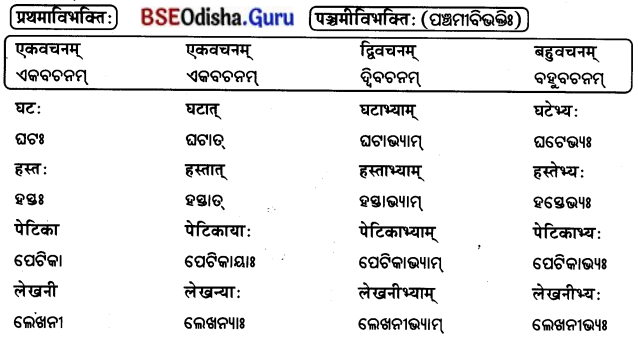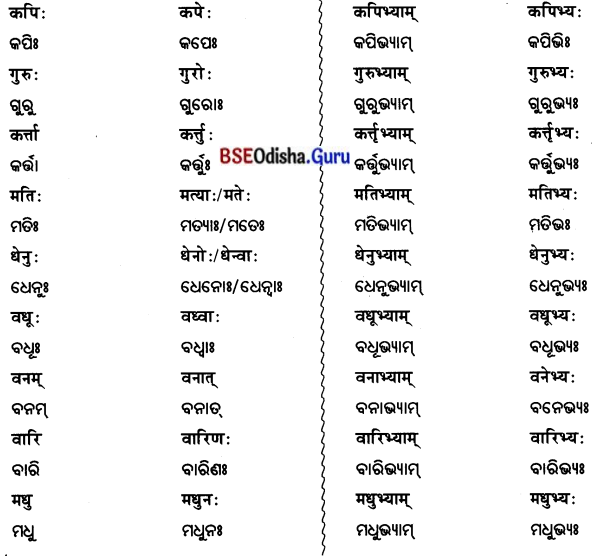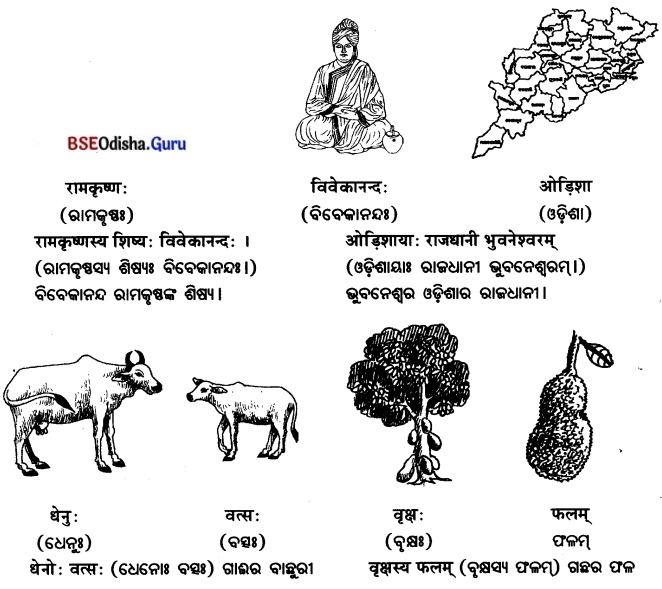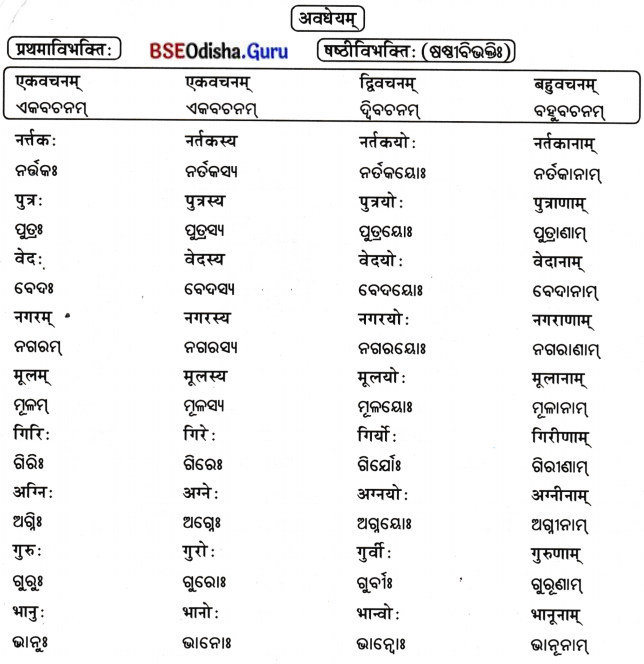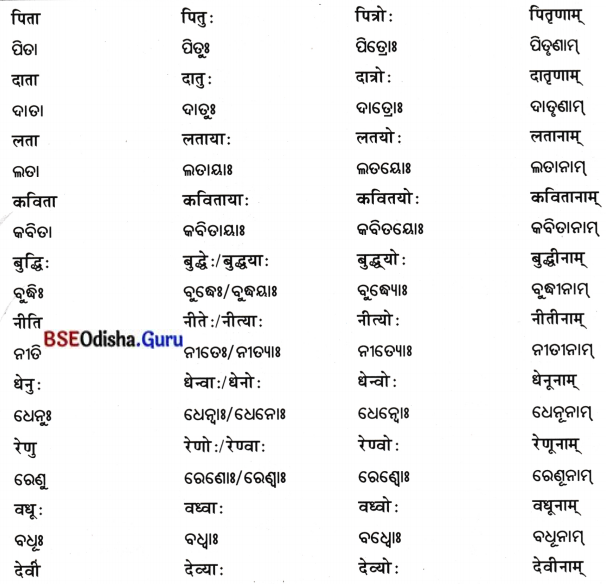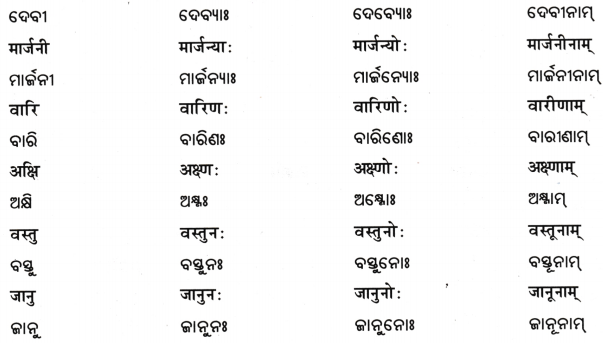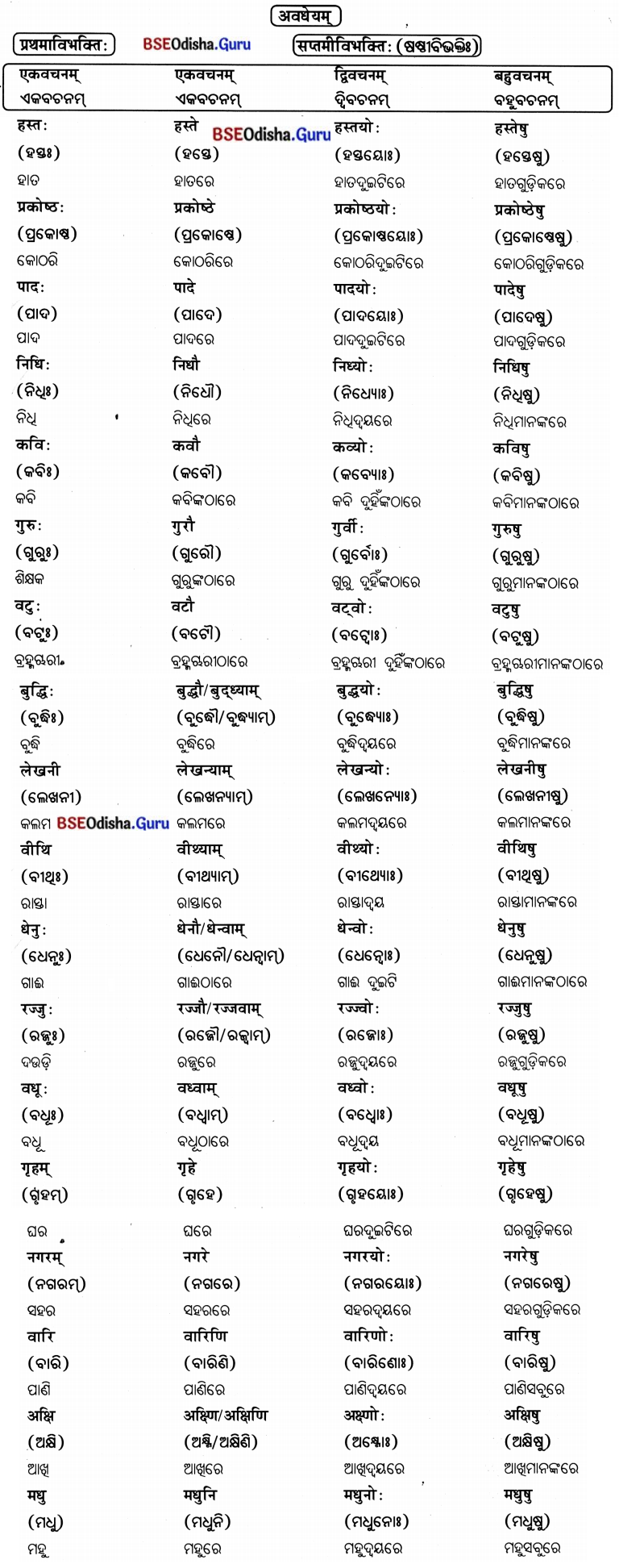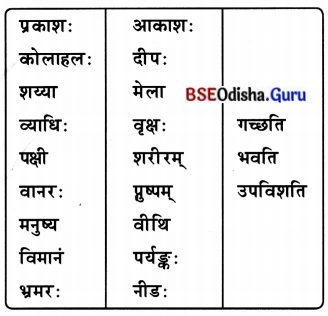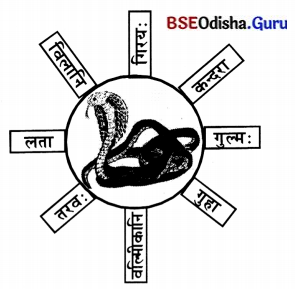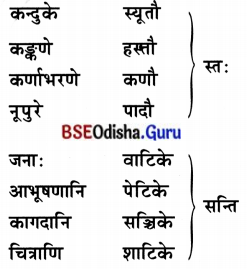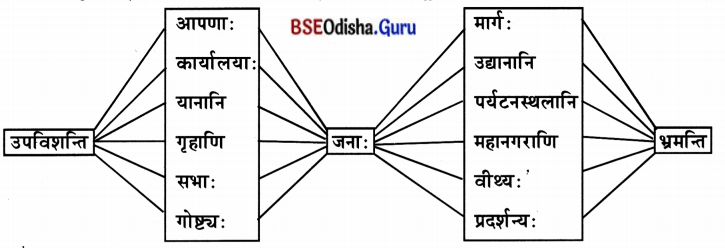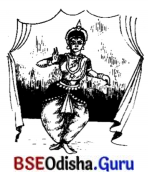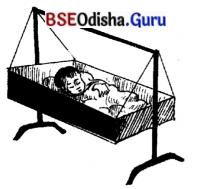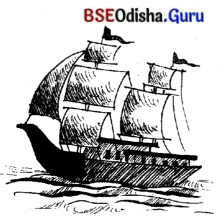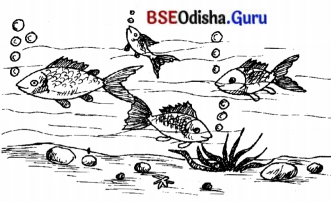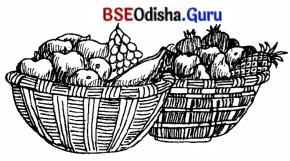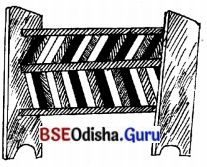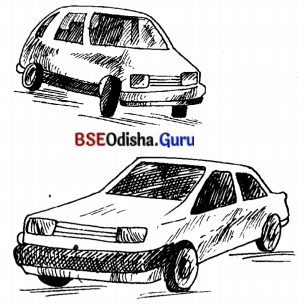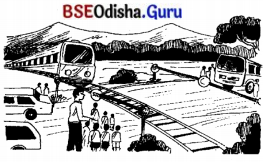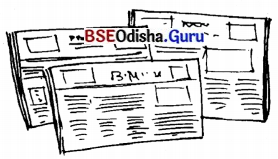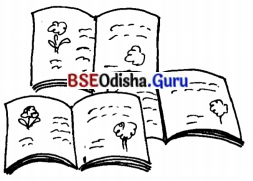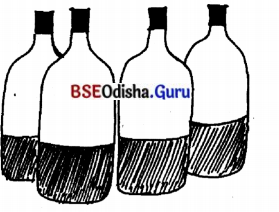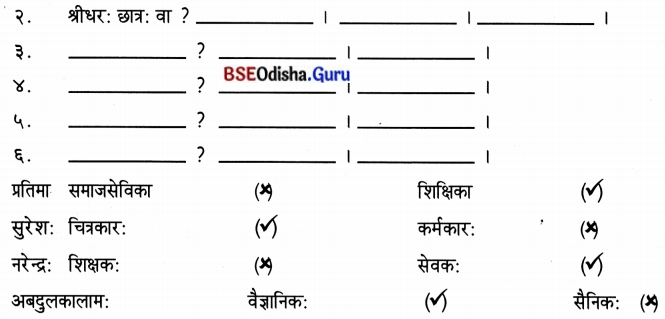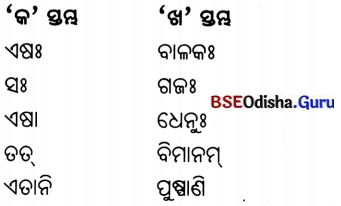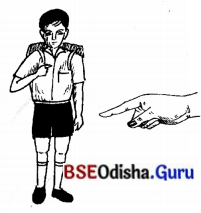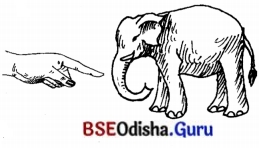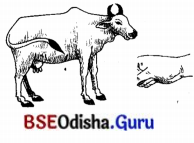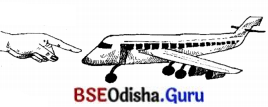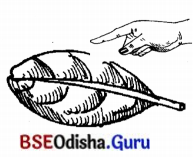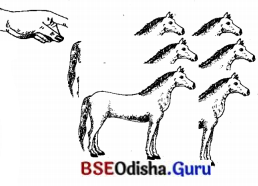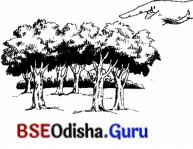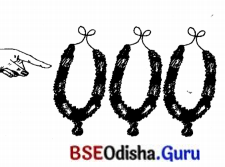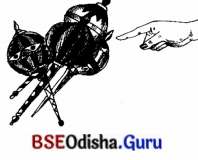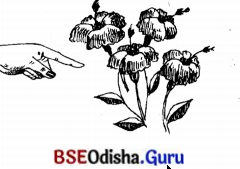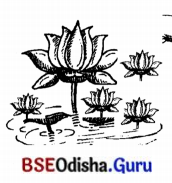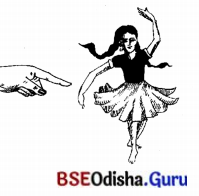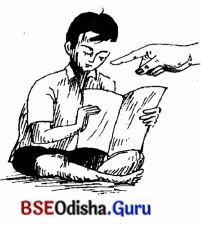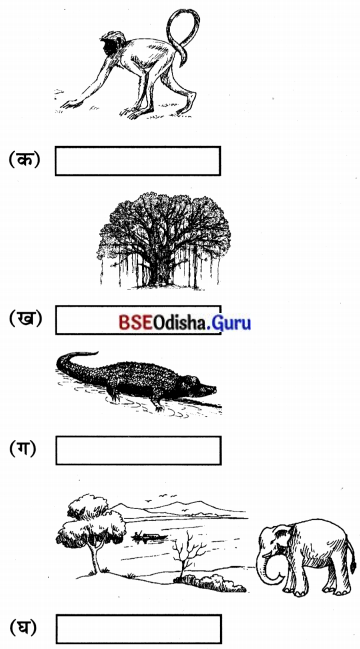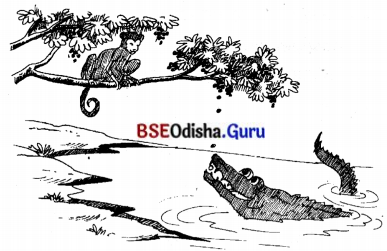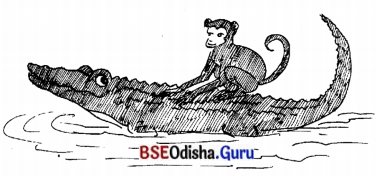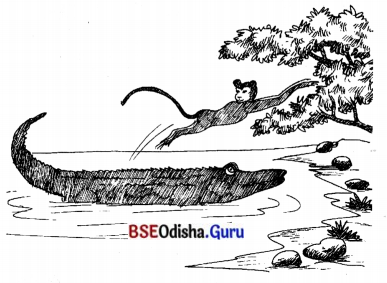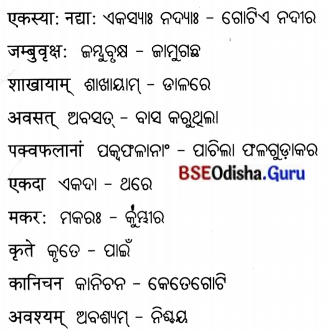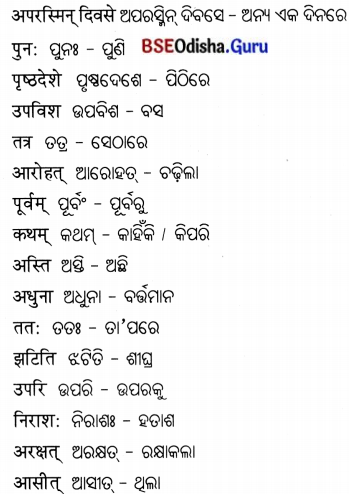Odisha State Board CHSE Odisha Class 12 Education Solutions Chapter 3 Sri Aurobindo Questions and Answers.
CHSE Odisha 12th Class Education Chapter 3 Question Answer Sri Aurobindo
Group – A
Short type Questions with Answers
1. Answer with in Two/Three sentence :
Question 1.
What is the primary aim of education according to Integral Education?
Answer:
The main aim of education is to help the growing soul draw out its best and make it perfect for a noble cause. The integral education focuses on the perfection of the soul as its ultimate goal.
Question 2.
How does Integral Education define the realization of inner self?
Answer:
Education should enable individuals to realize their inner self, which is a part of the universal consciousness. This realization involves establishing right relationships within oneself, with people of the country, and with the universal society to which one belongs.Realizing one’s inner self, and fostering harmonious relationships are key aspects of Integral Education.
Question 3.
Why does Integral Education emphasize physical development?
Answer:
Physical development of the child is crucial as it forms the foundation for other aspects of development. Without physical strength, mental and emotional development becomes challenging. Integral education recognizes the significance of physical well-being for overall growth.
Question 4.
What are the three essential factors for the moral development of a child according to Integral Education?
Answer:
Emotions, impressions or habits, and nature are the three essential factors for the moral development of a child. The ideals of a teacher should be high, allowing the child to imitate and reach higher stages of development.Moral and emotional development are considered integral to human progress.

Question 5.
According to Integral Education, how should education aim at training the senses?
Answer:
Education should aim at the training of senses, and according to Integral Education, senses can be trained fully when manas, chitta, and nerve’ are pure. Purification of the mind, consciousness, and nerves is seen as a prerequisite for sensory training.
Question 6.
How many levels of consciousness are identified in Integral Education, and what are they?
Answer:
There are four levels of consciousness according to Integral Education: Chitta, Manas, Intelligence, and Knowledge. A teacher should develop all these four levels harmoniously to promote the development of conscience. Harmonious development of consciousness is a key goal in Integral Education.
Question 7.
What does Integral Education emphasize regarding the harmony between the individual and collectivity?
Answer:
Integral Education emphasizes the realization of harmony not only between individuals but also between nations. Aurobindo’s scheme of education is truly international, aiming for mutual respect and understanding among individuals and nations.Harmony in both individual and collective relationships is a central theme in Integral Education.
Question 8.
What is the supreme value in Sri Aurobindo’s thought concerning the chaos of values?
Answer:
The supreme value in Sri Aurobindo’s thought is harmony. Other values include spirituality, divinity, evolution, ascent, and transformation. Sincerity is identified as the most important value required for all growth.Harmony and sincerity are fundamental values in the integral education philosophy.
Question 9.
What is the significance of spiritual evolution in Integral Education?
Answer:
Integral education aims at fostering spiritual evolution in individuals, emphasizing growth in the spiritual dimension beyond the material aspects of life. The goal is to guide individuals toward a higher state of consciousness, connecting them with the divine essence within. Spiritual evolution is a key aspect of Integral Education’s holistic approach.
Question 10.
How does Integral Education propose to unite the mind, heart, and body ?
Answer:
True education, according to Integral Education, should unite the different aspects of an individual mind, heart, and body. Integration of these elements is crucial for holistic development, ensuring a balanced and enlightened individual.The integration of mind, heart, and body is a fundamental principle in Integral Education.

Question 11.
Who is Aurobindo, and when and where was he born?
Answer:
Aurobindo was bom in Calcutta on August 15, 1872, into an educated middle-class family. He later went to England at the age of 7 and lived there for 14 years. His birth date seems to be incorrectly mentioned as 1972; it should be 1872.
Question 12.
Where did Aurobindo receive his education?
Answer:
Aurobindo received his education at Cambridge, mastering English, Latin, Greek, and learning French, German, and Spanish.
Question 13.
How did Aurobindo contribute to education in Baroda College, Gujarat?
Answer:
Upon returning from England, Aurobindo joined Baroda College as a professor of English in 1893. He not only immersed himself in cultural and literary activities but also learned Bengali, Gujarati, Marathi, and Sanskrit.
Question 14.
What were Aurobindo’s early contributions to the Indian National Congress?
Answer:
Aurobindo joined the Indian National Congress and became an active freedom fighter. Disappointed with the Moderates, he started the Bengali daily ‘Yugantar ’ and English daily ‘Bande Mataram’ to promote revolutionary ideas.
Question 15.
Why was Aurobindo considered a dangerous leader by the British government?
Answer:
Aurobindo’s revolutionary activities, including the publication of ‘ Yugantar ’ and ‘Bande Mataram,’ marked him as a threat to the British government, earning him the reputation of one of the most dangerous leaders.
Question 16.
What led to Aurobindo’s shift from a revolutionary to a philosopher and seer?
Answer:
In 1908, Aurobindo was sent to jail for the Alipore Bomb case. During this time, he turned to yoga, meditation, and the study of religious and spiritual literature, undergoing a transformative change.
Question 17.
Where did Aurobindo spend the remaining 40 years of his life, and what activities did he engage in?
Answer:
Aurobindo spent his remaining years in Pondicherry, establishing an Ashram. He focused on yoga, meditation, and various educational and social activities.
Question 18.
What were Aurobindo’s main ideas in philosophy?
Answer:
Aurobindo believed that everyone possesses something divine within them. The task is to find, develop, and use this divine aspect, attainable through a spiritual discipline called yoga.
Question 19.
Question: How did Aurobindo view yoga in relation to everyday life?
Answer:
Aurobindo’s concept of yoga differs from traditional views, as he believed it was for ordinary individuals engaged in worldly pursuits, not just ascetics. It involves regarding one’s work as divine and practicing fairness.

Question 20.
What was Aurobindo’s perspective on education, and how did he propose to cater to Indian needs?
Answer:
Aurobindo proposed integral education that addressed spiritual, rational, vital, and physical aspects. He set up an International Ashram and Centre of Education, tailoring educational theories to meet Indian requirements.
Question 21.
What were the main planes of mind according to Aurobindo?
Answer:
Aurobindo outlined different planes of mind, including the ordinary mind, higher mind, illuminated mind, intuitive mind, overmind,
and supermind, each serving distinct functions in human cognition and consciousness.
Question 22.
How did Aurobindo differentiate the ordinary mind into three parts?
Answer:
Aurobindo divided the ordinary mind into thinking mind, dynamic mind, and externalizing mind. The thinking mind deals with ideas, the dynamic mind with forces of realization, and the externalizing mind with expression in life.
Question 23.
What is Aurobindo’s perspective on the errors of the conceptual mind?
Answer:
Aurobindo believed that errors of the conceptual mind must be corrected by the supermind, acting as a link between ‘sachidananda’ and the universe, transcending knowledge and ignorance.
Question 24.
What is Aurobindo’s concept of supermind, and how can one acquire it?
Answer:
Aurobindo considered supermind a state of consciousness that can be gradually acquired through yoga. Once attained, it transforms the entire being, making one a ‘superman’ or Gnostic at their own plane.
Question 25.
How does Aurobindo define integral education, and what are its essential aspects?
Answer:
According to Aurobindo, true education is integral, encompassing spiritual, rational, vital, and physical dimensions. Integral education develops the individual, society, and humanity simultaneously, aiming for the evolution of total humanity. It involves the growth principle of unity in diversity.
II. Answer with in Five/Six sentence :
Question 1.
Can you provide a brief overview of Sri Aurobindo’s early life and education?
Answer:
Sri Aurobindo was bom on 15th August 1872, in Calcutta, into an educated middle class family. At the age of 7, he went to England, where he lived for 14 years. He received his education at Cambridge and, at 18, passed the entrance examination for the Indian Civil Service. Besides English, he mastered Latin, Greek, French, German, and Spanish. Upon his return to India in 1893, he joined Baroda College as a professor of English and engaged in cultural and literary activities. He later joined the Indian National Congress, becoming an active freedom fighter.
Question 2.
How did Sri Aurobindo’s imprisonment in 1908 lead to a profound transformation in his life, and what were the key elements of this change?
Answer:
Sri Aurobindo’s imprisonment in 1908, stemming from the Alipore Bomb case, marked a significant turning point in his life. During this period, confined to jail, he delved into yoga, meditation, and the study of religious, philosophical, and spiritual literature. This transformative experience shifted his focus from revolutionary activities to a more introspective and spiritual path. It was in prison that he underwent a profound inner change, embracing yoga and turning away from the intense political activism of his earlier years. This period of incarceration laid the foundation for his later spiritual and philosophical teachings.
Question 3.
What prompted Sri Aurobindo’s move to Pondicherry, and how did he spend the remaining 40 years of his life in his Ashram?
Answer:
Following his release from prison in 1909, Sri Aurobindo decided to withdraw from active politics and move to Pondicherry. In Pondicherry, he spent the remaining 40 years of his life in the Sri Aurobindo Ashram. During this time, he focused on spiritual practices, yoga, meditation, and the study of various religious and philosophical texts. Sri Aurobindo’s Ashram became a center for spiritual seekers, and he actively engaged in educational and social activities. His emphasis shifted from political endeavors to a holistic approach encompassing individual transformation, integral education, and the promotion of human unity.

Question 4.
What were Sri Aurobindo’s contributions to education, and how did he envision the concept of integral education?
Answer:
Sri Aurobindo made significant contributions to education through his concept of integral education. He proposed that true education should be not only spiritual but also rational, vital, and physical. Integral education, as envisioned by Sri Aurobindo, incorporates five principal aspects related to the human being’s activities: physical, vital, mental, psychic, and spiritual. This education is designed to be complete, complementary, and lifelong. The integral school, according to Sri Aurobindo, aims at the evolution of total humanity, emphasizing unity in diversity. It prepares individuals to work first as human beings, then as citizens, and finally as individuals, fostering a natural and effective development without strain.
Question 5.
How did Sri Aurobindo’s views on mind differ from conventional perspectives and what were the various planes of mind he identified ?
Answer:
Sri Aurobindo’s concept of mind diverged from conventional ideas, considering the mind as a primary means of manifestation in humans, not merely a thing equated with the brain. He identified six planes of mind: the ordinary mind, higher mind, illuminated mind, intuitive mind, overmind, and supermind. Each plane serves distinct functions, from basic thinking to divine gnosis. Aurobindo emphasized the correction of conceptual mind errors by the supermind, acting as a link between sachidananda and the universe, bridging knowledge and ignorance.
Question 6.
What is integral education according to Sri Aurobindo, and what are its fundamental principles?
Answer:
Integral education, as envisioned by Sri Aurobindo, is not solely spiritual but also rational, vital, and physical. It encompasses five principal aspects: physical, vital, mental, psychic, and spiritual, aiming for complete and complementary development throughout one’s life. The education is integral in two senses inculcating all aspects of individual being and fostering the evolution of the individual, nation, and humanity. The ultimate goal is the evolution of total humanity, emphasizing unity in diversity. Strengthening mental and physical aspects, achieving the five principal aspects together, and developing the four aspects of truth are integral to this transformative education.
Question 7.
How did Sri Aurobindo describe the integral school and its role in the development of the individual, society, and humanity?
Answer:
According to Sri Aurobindo, the integral school aims at man-making, preparing the individual to function as a human being, citizen, and individual. Circles of moral responsibility proceed from wider to narrower. The school addresses the inversion of values causing present confusion, offering integral education that comes naturally, effectively, and without strain. The educahd, society, and humanity form the ultimate principles of individuality, commonality, and essentiality. The integral school integrates academic and social activities, providing opportunities for silence, collaboration, consultation, and lectures. It facilitates play, activity, discovery, innovation, and the development of the powers of the body, mind, and spirit.
Question 8.
What is integral education, and how does Sri Aurobindo define, its completeness in addressing the five principal activities of human beings?
Answer:
Integral education, as envisioned by Sri Aurobindo, is not solely spiritual but also rational, vital, and physical. It encompasses five principal aspects related to human activities: physical, vital, mental, psychic, and spiritual. The completeness of education lies in its simultaneous and harmonious development of these aspects throughout an individual’s life. Aurobindo’s integral education is twofold—it inculcates all five aspects of individual being and contributes to the evolution of the individual, nation, and ultimately, humanity. The ultimate aim is the evolution of total humanity, emphasizing unity in diversity and maintaining the growth of diversity.
Question 9.
How does the integral school, according to Sri Aurobindo, contribute to the evolution of an individual, society, and humanity?
Answer:
The integral school, in Sri Aurobindo’s vision, serves the ultimate aim of man-making. It prepares the individual’to function sequentially as a human being, a member of a nation, and finally, an individual. The circles of moral responsibility and loyalties progress from wider to narrower. Aurobindo identifies an inversion of values causing confusion in present times, proposing that
integral education naturally, effectively, and without strain addresses this confusion. The school is not isolated but integrated into society, providing opportunities for integral development through activities like silence, collaboration, consultation, lectures, play, activity, discovery, innovation, and the development of the powers of the body, mind, and spirit.
Question 10.
How does the integral education proposed by Sri Aurobindo reflect the principles of individuality, commonality, and essentiality?
Answer:
Sri Aurobindo’s integral education is founded on the principles of individuality, commonality, and essentiality. These principles represent the educand, society, and humanity, respectively. The education system must include the evolution of all three elements simultaneously, emphasizing that individuality, commonality, and essentiality should develop together. In the integral school, colleges, and universities, education is not isolated but practiced in society. The aims, curriculum, and teaching methods align with these principles, fostering the growth of the educand, society, and humanity, and contributing to the evolution of total humanity through unity in diversity.
Question 11.
What is the primary aim of education according to Sri Aurobindo, specifically in terms of the perfection of the soul?
Answer:
According to Sri Aurobindo, the primary aim of education is to assist the growing soul in extracting its best attributes and achieving perfection for a noble cause. Education, in this context, is a trans form ative journey that seeks to bring out the inherent qualities of the soul, molding it into a refined and virtuous state.
Question 12.
How does Sri Aurobindo emphasize the realization of the inner self as a crucial goal of education?
Answer:
Sri Aurobindo advocates for education to’enable individuals to realize their inner selves, acknowledging this inner self as a part of the universal consciousness. The goal extends beyond self-awareness, encouraging individuals to form right relationships within themselves, with fellow countrymen, and within the broader universal society to which they belong.
Question 13.
Discuss&ri Aurobindo’s perspective on the significance of physical development in the educational process.
Answer:
Physical development holds a significant place in Sri Aurobindo’s educational philosophy. He rejects the notion that physical strength and mental weakness are inversely correlated. Instead, he asserts that physical development is a prerequisite for overall development, emphasizing that without a sound physical foundation, other forms of development become unattainable.
Question 14.
How does Sri Aurobindo underscore the importance of morality in education, and what are the essential factors for moral development
Answer:
Sri Aurobindo places a strong emphasis on moral and emotional development, stating that mental development devoid of morality can be detrimental to human progress. He identifies three crucial factors for the moral development of a child: emotions, impressions or habits, and nature. Teachers, according to Sri Aurobindo, shoujd embody high ideals to serve as role models, allowing children to naturally progress to higher stages of moral development through imitation.

Question 15.
Explain the significance of the development of senses in Sri Aurobindo’s educational philosophy.
Answer:
According to Sri Aurobindo, education should aim at the comprehensive training of the senses. He posits that the full training of the senses is achievable only when manas, chitta, and nerves are pure. This highlights the interconnectedness of mental and spiritual purity with the complete development of sensory perception, emphasizing a holistic approach to education that encompasses both physical and metaphysical dimensions.
Question 16.
Explain Sri Aurobindo’s perspective on the development of consciousness in education.
Answer:
Sri Aurobindo identifies the development of consciousness as a pivotal aim of education, categorizing it into four levels: Chitta, Manas, Intelligence, and Knowledge. These levels represent facets of heightened awareness and understanding. To foster holistic development, a teacher, according to Sri Aurobindo, should intricately nurture all four levels, facilitating the growth of conscience. This approach emphasizes that education goes beyond the acquisition of knowledge and extends to the elevation of consciousness.
Question 17.
How does Sri Aurobindo address the balance between individuality and collectivity in his educational philosophy?
Answer:
Sri Aurobindo diverges from many socio-political thinkers by emphasizing the realization of harmony between individuals and nations. Rejecting the dichotomy of individualism versus collectivism, he advocates for a truly international educational scheme. This vision, as explained by The Mother, underscores the necessity for mutual respect and understanding between individuals and nations. The collective order and organization, based on goodwill, are seen as the means to lift humanity from its current chaotic state, aligning with the principles of the supra-mental knowledge revealed by Aurobindo.
Question 18.
Discuss the cultivation of values according to Sri Aurobindo’s educational philosophy, focusing on the crisis of values.
Answer:
Sri Aurobindo addresses the contemporary crisis of values, where traditional values are challenged, and new values struggle to find firm footing. Central to his thought is the supreme value of harmony, alongside other values like spirituality, divinity, evolution, ascent, and transformation. The critical value for growth, according to him, is sincerity. The cultivation of these values is considered essential for character formation and holistic development. The emphasis on values is integral to Sri Aurobindo’s educational philosophy as they guide individuals towards a purposeful and meaningful life.
Question 19.
How does Sri Aurobindo propose to shape the curriculum in his integral education system?
Answer:
Sri Aurobindo envisions a dynamic curriculum that caters to the diverse interests and latent faculties of children. Rejecting the confinement of education to a limited syllabus, he proposes an expansive approach where life itself becomes the canvas for learning. The curriculum is not an end in itself but a means to achieve integral personality development. It includes subjects that promote mental and spiritual growth, incorporating flexibility to meet individual needs. The integral curriculum spans primary, secondary, and university stages, encompassing a range of subjects from language and sciences to philosophy, sociology, and vocational education.
Question 20.
How does Sri Aurobindo stress the importance of methods of teaching in his educational philosophy?
Answer:
Sri Aurobindo emphasizes several principles for effective teaching. Love and sympathy for the child are foundational, creating an environment where the teacher serves as a guide and helper rather than a taskmaster. Education through the mother tongue is advocated to ensure a deeper connection with cultural and linguistic roots. Teaching according to the child’s interests, through self-experience, and learning by doing are key principles. Additionally, Sri Aurobindo encourages cooperation between teachers and students in the education process, aligning teaching methods with the child’s nature, considering the divinity within, and fostering a free environment for the child’s self-driven learning.
Question 21.
Explain Sri Aurobindo’s emphasis on the perfection of the soul as the main aim of education.
Answer:
Sri Aurobindo’s educational philosophy places the perfection of the soul at the forefront. He believes that education’s primary goal is to assist the growing soul in manifesting its best qualities and achieving perfection for a noble cause. According to Aurobindo, the soul’s perfection involves the realization and expression of its highest potential, contributing positively to the individual and society. This perspective transforms education into a profound journey of self-discovery and purposeful growth.
Question 22.
Elaborate on Sri Aurobindo’s views regarding the realization of inner self and the significance of right relationships.
Answer:
Sri Aurobindo underscores the importance of education in enabling individuals to realize their inner selves, which he considers a part of the universal consciousness. This realization goes beyond self-awareness; it involves establishing right relationships not only within oneself but also with fellow citizens and the global community. Aurobindo’s vision encompasses the idea that fostering harmonious connections is integral to personal and collective well-being, emphasizing the interconnectedness of individuals within the broader fabric of universal society.

Question 23.
Discuss Sri Aurobindo’s stance on the relationship between physical and mental development in education.
Answer:
Sri Aurobindo challenges the misconception that physical strength correlates with mental weakness. He asserts that physical development is a crucial aim of education and rejects the notion that mental development can thrive without a foundation in physical well-being. According to Aurobindo, a healthy body is essential for the holistic development of an individual. This perspective highlights the interconnectedness of physical and mental aspects, emphasizing that both dimensions must be nurtured concurrently for comprehensive human progress.
Question 24.
Explore Sri Aurobindo’s thoughts on the development of morality and its role in mental progress.
Answer:
Aurobindo contends that moral and emotional development is imperative for mental progress. He identifies three essential factors—emotions, impressions or habits, and nature—as fundamental to a child’s moral development. The teacher’s ideals play a pivotal role, as a child, through imitation, can reach higher stages of development. Aurobindo’s emphasis on morality recognizes its significance in shaping character and ensuring that mental development aligns with ethical principles, contributing positively to human advancement.
Question 25.
Explain the integral aim of training the senses in education, according to Sri Aurobindo.
Answer:
Sri Aurobindo advocates for the training of senses in education, asserting that it can be fully achieved when manas, chitta, and nerve are pure. This holistic approach involves refining not just sensory perceptions but also mental and nervous aspects. Aurobindo’s perspective implies that a balanced and purified state of mind and nerve is essential for the comprehensive development and training of the senses. By integrating these elements, education can facilitate a heightened and harmonious sensory experience, contributing to the overall growth and refinement of the individual.
Group – B
Long Type Questions With Answers
Question 1.
What are the key features of Sri Aurobindo’s philosophy of education, emphasizing the distinctive aspects that contribute to its holistic and transformative approach?
Answer:
Sri Aurobindo’s philosophy of education is a profound and holistic approach that goes beyond traditional notions of learning. Rooted in spiritual principles and a deep understanding of human consciousness, his educational philosophy aims at the integral development of individuals, encompassing physical, mental, moral, and spiritual dimensions. Here, we delve into the salient features of Aurobindo’s philosophy of education.
1. Integral Development : At the core of Aurobindo’s philosophy is the concept of integral development, which implies the harmonious growth of all aspects of an individual – physical, vital, mental, and spiritual. Unlike conventional education that often focuses on intellectual pursuits, Aurobindo’s approach recognizes the interconnectedness of these dimensions and advocates for their simultaneous evolution.
2. Perfection of the Soul: Aurobindo places a significant emphasis on the perfection of the soul as the ultimate aim of education. He believes that education should assist the growing soul in drawing out its inherent qualities and making it perfect for a noble cause. This perspective elevates the purpose of education from mere knowledge acquisition to a transformative journey that aligns an individual with higher ideals.
3. Realization of Inner Self : Integral education, according to Aurobindo, should enable individuals to realize their inner selves. This involves fostering self-awareness and facilitating a deep understanding of one’s connection to the universal consciousness. Aurobindo envisions education as a means for individuals to establish right relationships not only within themselves but also with others and the broader society.
4. Physical Development : Contrary to the separation often made between physical and mental development, Aurobindo stresses the importance of physical well-being. He argues that physical development is foundational, and without it, comprehensive human development is not possible. A healthy body is considered essential to support mental, emotional, and spiritual growth.
5. Development of Morality : Moral and emotional development holds a central place in Aurobindo’s philosophy. He identifies three essential factors – emotions, habits, and nature – that contribute to the moral development of a child. Teachers are seen as key influencers, and the ideals they embody play a crucial role in shaping the moral and ethical compass of students.
6. Training of Senses : Aurobindo advocates for the training of senses as part of education. This goes beyond sensory perception and involves the refinement of mental and nervous aspects. The purity of manas, chitta, and nerve is considered vital for the holistic development and training of the senses.
7. Development of Consciousness : Integral education aims at the development of consciousness, which Aurobindo categorizes into four levels – Chitta, Manas, Intelligence, and Knowledge. Teachers are entrusted with the task of fostering the harmonious development of these levels, promoting a heightened state of awareness and conscience in students.
8. Harmony of the Individual and Collectivity : Aurobindo’s philosophy transcends the dichotomy between individual and collective well-being. He advocates for the realization of harmony between individuals and nations, fostering a truly international approach. The emphasis is on collaboration, mutual respect, and understanding as essential components of a collective order and organization.
9. Cultivation of Values : The contemporary crisis, according to Aurobindo, is rooted in the chaos of values. His philosophy underscores the importance of cultivating values such as harmony, spirituality, divinity, evolution, ascent, and transformation. Sincerity is highlighted as the most crucial value, acting as a foundation for overall growth. .
10. Teacher’s Role: In Aurobindo’s philosophy, the teacher holds a pivotal role. Unlike traditional authoritarian models, the teacher is a guide and philosopher, aiming to turn the student’s eyes towards their own innate divinity. The teacher is expected to embody discipline, self-mastery, and an integrated personality, serving as an inspiration rather than an authority figure.
11. Practical Implications : The practical implications of Aurobindo’s philosophy manifest in a curriculum that goes beyond conventional subjects. The emphasis is on a holistic educational environment that nurtures physical fitness, intellectual curiosity, moral integrity, and spiritual consciousness. This approach prepares individuals not just for academic success but for a purposeful and fulfilling life contributing positively to society.
In conclusion, Sri Aurobindo’s philosophy of education stands as a testament to a comprehensive and transformative approach that seeks to unfold the latent potential within each individual. It goes beyond the limitations of conventional education, providing a roadmap for a harmonious and integrated development that is not only personally fulfilling but contributes to the greater good of humanity.

Question 2.
How does Sri Aurobindo conceptualize Integral Education, and what are the critical aspects that merit evaluation in assessing the effectiveness and significance of Integral Education?
Answer:
Sri Aurobindo’s concept of Integral Education is a profound and holistic approach that seeks to nurture not only the intellectual faculties of an individual but also addresses the emotional, physical, and spiritual dimensions. Rooted in the philosophy of integral yoga, Aurobindo’s educational vision extends beyond the conventional boundaries, aiming at the harmonious development of the entire being.
Integral Education, according to Sri Aurobindo, is a means of facilitating the evolution of an individual towards a higher state of consciousness and self-realization.
The main aims of this educational philosophy can be summarized as follows:
1. Perfection of Soul: Central to Aurobindo’s vision is the idea that education should guide the growing soul to unfold its inherent potential and strive for perfection. This perfection is not self-centered but aligns with a noble cause, emphasizing the importance of contributing positively to the collective.
2. Realization of Inner Self : Integral Education aims to enable individuals to realize their inner self, recognizing it as an integral part of the universal consciousness. This realization extends to cultivating right relationships not only within oneself but also with fellow beings and the larger universal society.
3. Physical Development : Contrary to the separation of physical and mental aspects, Aurobindo asserts that physical development is crucial. He rejects the notion that physical strength implies mental weakness and emphasizes that without physical development, overall progress is impeded.
4. Moral and Emotional Development : Aurobindo underscores the significance of moral and emotional growth, considering them essential for positive human progress. The teacher’s high ideals become a guiding force, shaping the child’s moral compass through imitation and example.
5. Development of Senses and Consciousness : Education, in Aurobindo’s view, should focus on training the senses, ensuring purity of mind, consciousness, and nerves. This training involves the harmonious development of different levels of consciousness – Chitta, Manas, Intelligence, and Knowledge – fostering the growth of conscience.
6. Harmony of Individual and Collectivity : Aurobindo’s educational philosophy transcends the emphasis on either the individual or collectivity. It strives for harmony, not only among individuals but also between nations, making it a truly international and collaborative endeavor.
7. Cultivation of Values: Recognizing the contemporary crisis in values, Aurobindo advocates for cultivating values such as harmony, spirituality, divinity, evolution, ascent, and transformation. Sincerity is identified as a paramount value essential for overall growth.
The critical evaluation of Integral Education involves assessing several key aspects:
1. Comprehensiveness: One must examine whether the integral approach encompasses all facets of human development – physical, vital, mental, psychic, and spiritual – ensuring a well- rounded education.
2. Practical Implementation : The effectiveness of Integral Education lies in its practical application. Evaluating how well the principles are translated into curriculum, teaching methods, and overall educational practices is crucial.
Adaptability: Integral Education should be adaptable to individual needs, providing flexibility and addressing the diverse requirements of learners.
3. Impact on Society : Assessing the broader impact of Integral Education on societal values, relationships, and overall well-being is vital to understanding its significance beyond individual development.
4. Alignment with Contemporary Needs : Given the dynamic nature of society, evaluating whether Integral Education aligns with contemporary needs and challenges ensures its relevance in evolving contexts.
In conclusion, Sri Aurobindo’s concept of Integral Education offers a comprehensive and transformative vision that extends beyond traditional educational paradigms. Its critical evaluation involves considering its holistic nature, practical application, adaptability, societal impact, and alignment with the changing needs of the times. Integral Education, if effectively implemented, has the potential to contribute significantly to the holistic development of individuals and societies.
Question 3.
What does Integral Education aim to achieve, and how can these objectives be effectively put into practice?
Answer:
Integral Education, as envisioned by Sri Aurobindo, encompasses a comprehensive set of objectives aimed at fostering the holistic development of an individual. The core principles underlying this educational philosophy include the perfection of the soul, realization of the inner self, physical development, morality, development of the senses, consciousness, harmony between the individual and collectivity, and the cultivation of values. To understand the objectives of Integral Education and explore practical implementations, it is crucial to delve into each aspect.
1. Perfection of Soul: Integral Education posits the idea that education should contribute to the perfection of the soul. Sri Aurobindo emphasizes the need to draw out the best within an individual and refine it for noble purposes. Practical implementation involves
creating an environment that encourages self-discovery, self-expression, and aligning personal aspirations with societal well-being.
2. Realization of Inner Self: Education, according to Aurobindo, should enable individuals to realize their inner selves, recognizing their connection to the universal consciousness. Practically, this can be achieved through introspective practices, mindfulness, and fostering a curriculum that encourages self-awareness and empathy towards others.
3. Physical Development : Integral Education recognizes the significance of physical development, debunking the notion that physical strength is inversely proportional to mental prowess. Incorporating physical activities, sports, and a focus on health and well-being can translate this objective into practice.
4. Development of Morality : Moral and emotional development is considered fundamental to mental progress. Teachers play a vital role in setting high moral standards, creating a value- driven atmosphere that guides students through ethical decision-making. By nurturing positive habits and ideals, the moral fabric of the educational community is strengthened.
5. Development of the Senses : Integral Education emphasizes the training of senses, suggesting that it is possible when the mind, consciousness, and nerves are pure. Practical implementation involves sensory-based learning approaches, experiential education, and activities that engage multiple senses for a comprehensive understanding of the world.
6. Development of Consciousness : Integral Education aims to develop consciousness through various levels—Chitta, Manas, Intelligence, and Knowledge. Teachers are tasked with harmoniously developing these levels, fostering a deeper understanding of oneself and the world. Practices like meditation and mindfulness can contribute to consciousness development.
7. Harmony Between Individual and Collectivity : Aurobindo proposes the realization of harmony not only among individuals but also between nations. To put this into practice, educational institutions need to instill values of mutual respect, understanding, and global citizenship. Curricula should emphasize collaborative projects, intercultural exchanges, and a broader perspective on societal roles.
8. Cultivation of Values : In a time of shifting values, Integral Education places harmony as a supreme value. Other values such as spirituality, divinity, evolution, ascent, and transformation are highlighted. Sincerity is underscored as a crucial value for overall growth. Practical application involves incorporating* these values into the ethos of the educational institution, ensuring sincerity is a guiding principle.
9. Translating Objectives into Practice : Practical implementation of Integral Education involves curriculum design that integrates these objectives seamlessly. Teachers serve as facilitators, mentors, and role models, embodying the values and principles of Integral Education. Beyond theoretical knowledge, emphasis should be placed on experiential learning, real-world applications, and fostering a sense of responsibility towards self, others, and the world.
Assessment methodologies should evolve to encompass not just academic achievements but also personal development, moral growth, and contributions to collective well-being. Collaborative learning environments, cross-disciplinary studies, and a focus on individualized learning paths can further enhance the effectiveness of Integral Education.
Ultimately, the success of Integral Education lies in creating a learning ecosystem that nurtures the multifaceted growth of individuals, preparing them not only for personal success but also for meaningful contributions to society and the world at large.

Question 4.
What were the pivotal life events that led Sri Aurobindo from being a revolutionary freedom fighter to becoming a philosopher and seer, ultimately shaping his educational ideologies?
Answer:
Aurobindo’s transformation from a revolutionary freedom fighter to a philosopher and seer, t roloundly influencing his educational ideologies, was marked by pivotal life events that shaped his spiritual journey. Born on August 15, 1872, in Calcutta, Aurobindo Ghosh’s early life was characterized by exposure to Western education, political activism, and a profound inner questi.
1. Early Education in England : At the age of seven, Aurobindo was sent to England for his education. He spent 14 years there, mastering English, Latin, and Greek, and acquiring knowledge of F rench, German, and Spanish. This exposure to Western thought and literature laid the foundation for his later engagement with the world of ideas and philosophies.
2. Return to India and Political Activism : In 1893, Aurobindo returned to India and joined Baroda College as a professor of English. He quickly became involved in cultural and literary activities. His engagement with Indian languages, including Bengali, Gujarati, Marathi, and Sanskrit, showcased his commitment to understanding and promoting Indian culture. However, he also entered the political arena, joining the Indian National Congress and advocating for India’s independence.
3. Revolutionary .Phase and Journalism : Disillusioned with the moderate approach of the Congress, Aurobindo took a radical turn. He started the Bengali daily ‘Yugantar’ and the English daily ‘Bande Mataram’ to propagate his revolutionary ideas. His writings were critical of British rule, and he was regarded as one of the most dangerous leaders by the colonial government. This phase led to his involvement in revolutionary activities, and he faced imprisonment for the Alipore Bomb case in 1908.
4. Shift to Spirituality in Prison: During his incarceration, Aurobindo underwent a profound inner transformation. Influenced by his reading of Hindu scriptures and exposure to spiritual literature, he turned to yoga, meditation, and the study of religious and philosophical texts. This marked the beginning of his spiritual evolution, and he experienced deep meditative states that altered his perception of reality.
5. Move to Pondicherry : Following his release from prison, Aurobindo moved to Pondicherry in 1910, seeking a more conducive environment for his spiritual pursuits. This marked a crucial turning point in his life. He gradually withdrew from active political involvement and dedicated himself to spiritual practices and the exploration of higher states of consciousness.
6. Evolution of Integral Yoga : In Pondicherry, Aurobindo developed his philosophy of Integral Yoga, which aimed at the evolution of consciousness and the synthesis of the spiritual and material dimensions of life. Integral Yoga became the cornerstone of his spiritual teachings and influenced his views on education.
7. Educational and Social Initiatives : Aurobindo, along with his spiritual collaborator The Mother, initiated various educational and social projects in Pondicherry. The establishment of the Sri Aurobindo Ashram and the International Centre of Education reflected his vision of an integral approach to learning, encompassing the physical, vital, mental, psychic, and spiritual dimensions.
8. Evolution of Educational Philosophy : The experiences in Pondicherry, coupled with his spiritual realizations, deeply influenced Aurobindo’s educational philosophy. He emphasized the integral development of the individual, promoting not just academic excellence but the harmonious growth of all facets of one’s being. His philosophy advocated a shift from traditional rote-based learning to a system that nurtures the complete personality.
In conclusion, the pivotal life events in Sri Aurobindo’s journey, from his early education in England to his revolutionary phase and eventual spiritual transformation in Pondicherry, played a crucial role in shaping his educational ideologies. The fusion of Western education, political activism, and spiritual exploration laid the foundation for a holistic approach to learning that continues to inspire the educational philosophy of Integral Education today.
Question 5.
How does Sri Aurobindo advocate for a national system of education, and What characteristics does he propose for such a system? Discuss the elements such as human and spiritual values, the balance between national and international perspectives, and the role of moral education within the national system.
Answer:
Sri Aurobindo passionately advocated for a national system of education that wou-a align with the cultural and spiritual heritage of India while incorporating modr i knowledge nd scientific progress. His vision aimed at fostering a holistic development of indivui „.ds, nurti.’ mg ncr only intellectual capabilities but also moral and spiritual values. Several key characteristics distinguish Aurobindo’s proposed national system of education:
1. Integration of Human and Spiritual Values : Central to Aurobindo s vision was the integration of human and spiritual values in education. He believed that education should not merely focus on intellectual development but should encompass the broader dimensions of human existence. The aim was to instill a sense of purpose and meaning in life, emphasizing virtues such as compassion, empathy, and ethical conduct.
2. Complementary Nature of Human and Spiritual Values : Aurobindo saw human and spiritual values as complementary and mutually reinforcing. Education, in his view, should strike a harmonious balance between the material and the spiritual aspects of life. By incorporating both dimensions, individuals could achieve a more comprehensive understanding of themselves and their role in society.
3. Avoiding Superficial Nationalism : Aurobindo cautioned against a superficial understanding of nationalism. He emphasized that merely appending the term ‘national’ to an educational system did not make it genuinely national. Instead, he advocated for a system deeply rooted in the cultural, spiritual, and philosophical traditions of India, providing a foundation for a sense of national identity and pride.
4. Emphasis on Modern Knowledge and Scientific Progress : While advocating for a national system deeply rooted in Indian culture, Aurobindo recognized the importance of embracing modem knowledge and scientific progress. He believed that a national education system should equip individuals with the skills and knowledge required to engage with the contemporary world. This balance between tradition and modernity aimed at producing individuals capable of contributing to the global community.
5. Role of Moral Education : Moral education held a central position in Aurobindo’s vision of a national system. He believed that the cultivation of moral values was essential for the overall development of individuals. This moral education was not based on mere dictation or imposition of rules but rather on personal examples of teachers, exposure to literature with lofty examples, and fostering an environment of‘Satsanga’or good company.
6. Balanced Understanding of National and International Relationships : Aurobindo advocated for a balanced understanding of national and international relationships. He believed that individuals educated within the national system should possess a sense of universal humanity, recognizing the interconnectedness of nations. This understanding aimed at nurturing a spirit of cooperation and collaboration on a global scale.
7. Discipline – Chitta Shuddhi (Purification of the Mind and Morals) : Discipline in Aurobindo’s national education system was not merely about rules and regulations but centered around ‘Chitta Shuddhi’ – the purification of the mind and morals. It involved the discrimination between right and wrong impressions, emphasizing ethical conduct and moral discernment.
In conclusion, Sri Aurobindo’s advocacy for a national system of education was deeply rooted in the synthesis of Indian spiritual values and modem knowledge, aiming at the holistic development of individuals. The emphasis on moral education, the complementary nature of human and spiritual values, and a balanced approach to nationalism distinguished his vision, providing a nuanced perspective on education that transcends narrow boundaries and contributes to the broader welfare of humanity.
Group – C
Objective type Questions with Answers
1. Multiple Choice Questions with Answers :
Question 1.
When was Sri Aurobindo Ghosh born?
(i) 1857
(ii) 1872
(iii) 1893
(iv) 1908
Answer:
(ii) 1872
Question 2.
At what age did Sri Aurobindo go to England and live there for 14 years?
(i) 5
(ii) 7
(iii) 18
(iv) 40
Answer:
(ii) 7
Question 3.
What languages did Sri Aurobindo master besides English?
(i) Latin and Greek
(ii) French, German, and Spanish
(iii) Bengali, Gujarati, Marathi, and Sanskrit
(iv) All of the above
Answer:
(iv) All of the above
Question 4.
In which year did Sri Aurobindo join as a professor of English at Baroda College in Gujarat?
(i) 1857
(ii) 1872
(iii) 1893
(iv) 1908
Answer:
(iii) 1893
Question 5.
What were the names of the newspapers started by Sri Aurobindo to promote his revolutionary ideas?
(i) Yugantar and Bande Mataram
(ii) Hindustan Times and The Times of India
(iii) Freedom Fighter and Revolution Today
(iv) Patriot and Swaraj
Answer:
(i) Yugantar and Bande Mataram
Question 6.
For which case was Sri Aurobindo sent to jail in 1908?
(i) Quit India Movement
(ii) Jallianwala Bagh Massacre
(iii) Alipore Bomb Case
(iv) Non-Cooperation Movement
Answer:
(iii) Alipore Bomb Case

Question 7.
Where did Sri Aurobindo spend his remaining 40 years after leaving jail?
(i) Delhi
(ii) Mumbai
(iii) Pondicherry
(iv) Kolkata
Answer:
(iii) Pondicherry
Question 8.
What did Sri Aurobindo turn to during his time in jail, leading to a significant transformation in his life?
(i) Politics
(ii) Yoga, meditation, and study of religious, philosophical, and spiritual literature
(iii) Literature
(iv) Business
Answer:
(ii) Yoga, meditation, and study of religious, philosophical, and spiritual literature
Question 9.
What is the concept of yoga according to Sri Aurobindo?
(i) A practice for sanyasis only
(ii) A discipline for turning away from life
(iii) A spiritual discipline for ordinary individuals amidst worldly pursuits
(iv) A physical exercise routine
Answer:
(iii) A spiritual discipline for ordinary individuals amidst worldly pursuits
Question 10.
How does Sri Aurobindo define the mind in his philosophy?
(i) A tangible object
(ii) The brain
(iii) A function or process
(iv) A temporary state
Answer:
(iii) A function or process
Question 11.
According to Sri Aurobindo, what is the highest state of consciousness?
(i) Ordinary mind
(ii) Higher mind
(iii) Intuitive mind
(iv) Supermind
Answer:
(iv) Supermind
Question 12.
What is the ultimate aim of education according to Sri Aurobindo?
(i) Economic success
(ii) Spiritual evolution
(iii) Political power
(iv) Social recognition
Answer:
(ii) Spiritual evolution
Question 13.
How many aspects does Sri Aurobindo propose for integral education?
(i) Two
(ii) Three
(iii) Four
(iv) Five
Answer:
(iv) Five
Question 14.
What are the five principal aspects of integral education according to Sri Aurobindo?
(i) Physical, vital, mental, psychic, and spiritual
(ii) Reading, writing, arithmetic, science, and art
(iii) Social, economic, political, cultural, and environmental
(iv) None of the above
Answer:
(i) Physical, vital, mental, psychic, and spiritual
Question 15.
What does Sri Aurobindo emphasize as the principle of growth in his scheme of evolution?
(i) Uniformity
(ii) Unity in diversity
(iii) Isolation
(iv) Competition
Answer:
(ii) Unity in diversity

Question 16.
What is the ultimate aim of education according to the provided text?
(i) Job preparation
(ii) Nation-building
(iii) Individual development
(iv) Integral development
Answer:
(iii) Individual development
Question 17.
According to the passage, what is the order of .moral responsibility and loyalties in integral education?
(i) Narrower to wider
(ii) Simultaneous development
(iii) Wider to narrower
(iv) Unspecified order
Answer:
(iii) Wider to narrower
Question 18.
What are the important aspects of integral education mentioned in the text?
(i) Physical and mental only
(ii) Physical, vital, mental, psychic, and spiritual
(iii) Psychic, vital, and physical only
(iv) Mental, spiritual, and physical only
Answer:
(ii) Physical, vital, mental, psychic, and spiritual
Question 19.
According to Sri Aurobindo, what are the four aspects of truth that need development?
(i) Love, knowledge, power, and beauty
(ii) Truth, honesty, integrity, and courage
(iii) Wisdom, justice, strength, and aesthetics
(iv) Morality, intelligence, authority, and aesthetics
Answer:
(i) Love, knowledge, power, and beauty
Question 20.
What does Sri Aurobindo believe are the ultimate principles of individuality, commonality, and essentiality ?
(i) Educand, society, and humanity
(ii) Teacher, student, and curriculum
(iii) Mind, body, and soul
(iv) Lectures, consultations, and collaborations
Answer:
(i) Educand, society, and humanity
Question 21.
According to integral education, what is the purpose of the school?
(i) Isolation from society
(ii) Total education in isolation
(iii) Development of silence and lectures
(iv) Development of educand’s body, mind, and spirit
Answer:
(iv) Development of educand’s body, mind, and spirit
Question 22.
What are the four types of rooms required in an integral school for various activities ?
(i) Play, activity, discovery, and innovation
(ii) Silence, collaboration, consultation, and lecture
(iii) Physical, vital, mental, and psychic
(iv) Art, painting, photography, and sculptural
Answer:
(ii) Silence, collaboration, consultation, and lecture
Question 23.
According to the aims of education in integral education, what is the main aim related to the soul?
(i) Physical development
(ii) Realization of inner self
(iii) Harmony of individual and collectivity
(iv) Cultivation of values
Answer:
(ii) Realization of inner self
Question 24.
What is the significance of physical development in integral education?
(i) A misguiding aspect
(ii) The only important aim
(iii) Essential for mental development
(iv) Irrelevant to overall growth
Answer:
(iii) Essential for mental development

Question 25.
What does Sri Aurobindo consider the most important value in his thought?
(i) Spirituality
(ii) Sincerity
(iii) Evolution
(iv) Harmony
Answer:
(ii) Sincerity
Question 26.
What is the emphasis of Sri Aurobindo’s educational scheme regarding individuals and nations?
(i) Isolationism
(ii) International collaboration
(iii) Individual focus
(iv) Nationalism
Answer:
(ii) International collaboration
Question 27.
What is the primary aim of vocational education in integral education?
(i) Academic excellence
(ii) Artistic skills
(iii) Integral development
(iv) Job placement
Answer:
(iii) Integral development
Question 28.
What does Sri Aurobindo suggest about the curriculum in integral education?
(i) Limited to a syllabus and textbooks
(ii) Only academic subjects
(iii) Flexible, promoting mental and spiritual development
(iv) Focused on leisure pursuits only
Answer:
(iii) Flexible, promoting mental and spiritual development
Question 29.
According to the principles of curriculum in integral education, what is the curriculum’s end goal?
(i) Academic achievement
(ii) Curriculum development
(iii) Development of integral personality
(iv) Development of specific skills
Answer:
(iii) Development of integral personality
Question 30.
Which of the following is NOT mentioned as a subject in the university stage of integral education?
(i) Indian and western philosophy
(ii) History of Civilization
(iii) Chemistry
(iv) National History
Answer:
(iv) National History
Question 31.
What did Sri Aurobindo emphasize regarding the teacher’s role in education?
(i) Absolute authority
(ii) Instructor and taskmaster
(iii) Helper and guide
(iv) Dictator and disciplinarian
Answer:
(iii) Helper and guide
Question 32.
According to Sri Aurobindo, what is the basis of genuine education?
(i) Rote learning
(ii) Teacher’s instructions
(iii) Exploration of the human mind
(iv) Following a strict curriculum
Answer:
(iii) Exploration of the human mind

Question 33.
Which principle of teaching involves working from the known to the unknown?
(i) Random exploration
(ii) Trial and error
(iii) From far to near
(iv) From near to far
Answer:
(iv) From near to far
Question 34.
What is the role of the teacher, according to Sri Aurobindo?
(i) Absolute authority figure
(ii) Taskmaster
(iii) Philosopher and guide
(iv) Dictator
Answer:
(iii) Philosopher and guide
Question 35.
What did Sri Aurobindo compare the teacher to?
(i) Dictator
(ii) Gardener
(iii) Ruler
(iv) Master
Answer:
(ii) Gardener
Question 36.
According to The Mother, what is the most important thing in a teacher?
(i) Knowledge
(ii) Discipline
(iii) Attitude
(iv) Authority
Answer:
(iii) Attitude
Question 37.
What did Sri Aurobindo advocate for in the national system of education?
(i) Denationalizing and degrading
(ii) International system
(iii) Spiritual values
(iv) Dictatorship
Answer:
(iii) Spiritual values
Question 38.
According to Sri Aurobindo, what is the true aim of physical education?
(i) Athletic prowess
(ii) Perfection
(iii) Competitiveness
(iv) Scientific progress
Answer:
(ii) Perfection
Question 39.
How does Sri Aurobindo view the teacher’s influence in moral education?
(i) Commanding and imposing
(ii) Setting personal examples
(iii) Ignoring examples
(iv) Being dictatorial
Answer:
(ii) Setting personal examples
Question 40.
What are the main characteristics of the national system of education according to Aurobindo?
(i) Isolationism
(ii) Complementary human and spiritual values
(iii) Tagging the word ‘national’
(iv) Neglect of modem knowledge
Answer:
(ii) Complementary human and spiritual values
Question 41.
What is the foundation of discipline according to Sri Aurobindo?
(i) Authoritarianism
(ii) Purification of mental and moral habits
(iii) Punishment
(iv) Dictatorship
Answer:
(ii) Purification of mental and moral habits

Question 42.
Which educational institution was originally started in 1943 for the children of Sri Aurobindo’s disciples?
(i) Baroda College
(ii) Auroville
(iii) The International Centre of Education
(iv) The Ashram School
Answer:
(iv) The Ashram School
Question 43.
What does Sri Aurobindo aim to emphasize through The International Centre of Education?
(i) Specialized knowledge
(ii) Unity of all knowledge
(iii) Isolationism
(iv) Neglect of society
Answer:
(ii) Unity of all knowledge
Question 44.
What are the objectives of The International Centre of Education?
(i) Promote isolationism
(ii) Develop a sense of division
(iii) Emphasize unity of all knowledge
(iv) Ignore international harmony
Answer:
(iii) Emphasize unity of all knowledge
Question 45.
According to The Mother, what qualifications must a good teacher possess?
(i) Absolute authority
(ii) Good yogi, integrated personality, and saintly qualities
(iii) Knowledge and expertise
(iv) Authoritarianism and impatience
Answer:
(ii) Good yogi, integrated personality, and saintly qualities
II. Fill in the blanks :
Question 1.
Aurobindo was bom in Calcutta on ______.
Answer:
15th August 1872.
Question 2.
Aurobindo went to England at the age of ______ and lived there for ______ years.
Answer:
7; 14.
Question 3.
Aurobindo received his education at ______.
Answer:
Cambridge.
Question 4.
At the age of 18, Aurobindo passed the entrance examination of the ______.
Answer:
Indian Civil Service
Question 5.
Besides English, Aurobindo mastered ______ and _____ and learned French, German, and Spanish.
Answer:
Latin; Greek.
Question 6.
In 1893, on his return from England, Aurobindo joined as a professor of English at ______in Gujarat.
Answer:
Baroda College.
Question 7.
Aurobindo initiated the establishment of an International Ashram and International Centre of Education and Soqial Activities in ______.
Answer:
Pondicherry.

Question 8.
Auroville, as a “city of human unity,” was his experiment in ______ in India.
Answer:
Pondicherry.
Question 9.
Aurobindo started the Bengali daily ______ and English daily ______ to promote his revolutionary ideas.
Answer:
Yugantar; Bande Mataram.
Question 10.
In 1908, Aurobindo was sent to jail for the ______ .
Answer:
Alipore Bomb case.
Question 11.
During his time in jail, Aurobindo turned to ______, meditation, and the study of religious, philosophical, and spiritual literature.
Answer:
Yoga.
Question 12.
Aurobindo spent his remaining 40 years in his Ashram in ______.
Answer:
Pondicherry.
Question 13.
Aurobindo proposed theories of education that catered to ______ needs.
Answer:
Indian.
Question 14.
Aurobindo set up an International Ashram and International Centre of Education and Social Activities, and also started the experiment known as ______.
Answer:
Auroville.
Question 15.
According to Aurobindo, everyone has something ______ within them.
Answer:
Divine.

Question 16.
Aurobindo’s concept of yoga is not for a ‘sanyasi’ who turns away from life but for the ordinary man who carries on his ______ pursuits.
Answer:
Worldly
Question 17.
Aurobindo’s concept of mind includes different planes, such as the ordinary mind, higher mind, illuminated mind, intuitive mind, over mind, and ______ .
Answer:
Super mind.
Question 18.
According to Aurobindo, errors of the conceptual mind must be corrected by the ______ .
Answer:
Super mind.
Question 19.
Integral education, according to Aurobindo, is not only spiritual but also ______ vital, and physical.
Answer:
Rational.
Question 20.
The ultimate aim of education, according to Aurobindo, is the evolution of ______ humanity.
Answer:
Total.
Question 21.
Integral education aims at the perfection of the ______ .
Answer:
soul
Question 22.
Education according to integral principles emphasizes the realization of one’s ______.
Answer:
inner self
Question 23.
Physical development is considered an important aim of education, as without it, no other ______ is possible.
Answer:
development

Question 24.
Moral and emotional development are essential factors for preventing harmful ______ progress. Answer: mental
Question 25.
Training of senses is a key goal in education, and according to integral education, senses can be fully trained when ______ are pure.
Answer:
manas, chitta, and nerve
Question 26.
Integral education focuses on developing consciousness, which has four levels: Chitta, Manas, Intelligence, and ______.
Answer:
Knowledge
Question 27.
Aurobindo emphasizes the harmony between individuals and nations, making his educational scheme truly ______.
Answer:
international
Question 28.
The chaos of values is a crisis in modern times, and Aurobindo’s supreme value is ______.
Answer:
harmony
Question 29.
Aurobindo’s integral curriculum includes subjects for the primary stage, such as Mother Tongue, English, National History, Art, Painting, General Science, Social Studies, and ______.
Answer:
Arithmetic
Question 30.
Aurobindo’s method of teaching encourages learning through ______ experience.
Answer:
self
Question 31.
The principles of teaching stress the importance of the teacher as a guide, not an ______.
Answer:
instructor

Question 32.
According to Aurobindo, the mind’s growth should be consulted, and the child should not be molded into, a shape desired by ______.
Answer:
parent or teacher
Question 33.
The first principle of learning in integral education is ______.
Answer:
concentration .
Question 34.
Aurobindo emphasizes the role of the teacher as a guide and ______ in the educational process.
Answer:
philosopher
Question 35.
Aurobindo stresses the importance of a teacher’s perfect ______ in fostering a perfect attitude in pupils.
Answer:
attitude
Question 36.
Aurobindo argued for a national system of education to prevent denationalizing, degrading, and impoverishing the mind, soul, and ______.
Answer:
character
Question 37.
The main characteristics of the national system of education include complementary and supplementary human and ______ values.
Answer:
spiritual
Question 38.
Aurobindo’s contributions to education include the establishment of the Ashram School and the ______ Centre of Education.
Answer:
International
Question 39.
The objectives of the International Centre of Education include emphasizing the unity of all ______ and developing the sense of oneness of mankind.
Answer:
knowledge

Question 40.
According to Aurobindo, physical education is crucial for the fulfillment of ______ .
Answer:
dharma
Question 41.
Discipline in integral education is based on the purification of ______ and moral habits.
Answer:
mental
Question 42.
The Ashram School, started in 1943, expanded gradually from a Primary School to a full fledged ______.
Answer:
High School
Question 43.
Aurobindo emphasizes the role of the teacher as a ______ who guides the student towards the divine within.
Answer:
gardener
Question 44.
Aurobindo’s principles of teaching include working from ______ to far, from the known to unknown.
Answer:
near
Question 45.
Aurobindo’s integral education focuses on the development of the ______ personality, including the physical, vital, mental, psychic, and spiritual aspects.
Answer:
integral
II. Correct the Sentences :
Question 1.
Aurobindo was born in an educated middle class family in Calcutta on 15th Aug.1972.
Answer:
Aurobindo was bom in an educated middle-class family in Calcutta on 15th Aug. 1872.
Question 2.
In ! 893, on his return from England, he joined as a professor of English at Baroda College in Gujarat.
Answer:
In 1893, on his return from England, he joined as a professor of English at Baroda College in Gujarat.
Question 3.
He started the Bengali daily Yugantar‘ and English daily Bande Mataram’ to promote his revolutionary ideas.
Answer:
He started the Bengali daily Yugantar’ and the English daily Bande Mataram’ to promote his revolutionary ideas.

Question 4.
In 1908, he was sent to jail for the Alipore Bomb case.
Answer:
In 1908, he was sent to jail in the Alipore Bomb case.
Question 5.
Aurobindo’s scheme of education is integral in two senses.
Answer:
Aurobindo’s scheme of education is integral in two senses:
Question 6.
The ultimate goal of education is the evolution of total humanity.
Answer:
The ultimate goal of education is the evolution of total humanity.
Question 7.
True education, according to SriAurobindo, is not only spiritual but also rational, vital, and physical.
Answer:
True education, according to SriAurobindo, is not only spiritual but also rational, vital, and physical.
Question 8.
Sri Aurobindo Ghosh prescribed a free environment for the children to develop all the latent faculties to the full and suggested all those subjects and activities of child’s interest to be included in the principles of curriculum.
Answer:
Sri Aurobindo Ghosh prescribed a free environment for children to develop all latent faculties to the full and suggested that all subjects and activities of a child’s interest be included in the principles of the curriculum.
Question 9.
The ultimate aim of education is man-making.
Answer:
The ultimate aim of education is man-making.
Question 10.
The teacher remains the philosopher and the guide. The Guru does not have absolute authority.
Answer:
The teacher remains the philosopher and guide. The Guru does not have absolute authority.
Question 11.
Aurobindo pointed out the following elements:
Answer:
Aurobindo pointed out the following elements:
Question 12.
The objectives underlying the centre are:
Answer:
The objectives underlying the centre are:

Question 13.
Hence, Shri Aurobindo saw education as a tool for the real working of the spirit of the mind, a body of the nation and individual.
Answer:
Hence, Shri Aurobindo saw education as a tool for the real working of the spirit of the mind, the body of the nation, and the individual.
Question 14.
According to the Educational Philosophy of him, everyone has spiritual consciousness by some extent in the form of some special ability which should be recognized and allowed to progress by the teacher.
Answer:
According to his Educational Philosophy, everyone has spiritual consciousness to some extent in the form of some special ability, which should be recognized and allowed to progress by the teacher.
Question 15.
Lastly, he extended his philosophy into the sphere of education at the Ashram with the setting up of Sri Aurobindo International Centre of Education.
Answer:
Lastly, he extended his philosophy into the sphere of education at the Ashram by setting up Sri Aurobindo International Centre of Education.
III. Answer the following questions in one word :
Question 1.
What is the primary aim of education according to integral education?
Answer:
The primary aim is the perfection of the soul for a noble cause.
Question 2.
According to integral education, what should education enable an individual to realize?
Answer:
Education should enable individuals to realize their inner selves, a part of the universal consciousness, fostering right relationships within and with society.
Question 3.
Why does integral education emphasize physical development in children?
Answer:
Physical development is considered essential for overall development, and without it, other forms of development are not possible.
Question 4.
Why is moral and emotional development emphasized in integral education?
Answer:
Without moral and emotional development, mental development can be harmful to human progress.
Question 5.
What is the significance of training the senses in integral education?
Answer:
Training of senses is crucial for integral education and is possible when manas, chitta, and nerve are pure.

Question 6.
How many levels of consciousness does integral education aim to develop?
Answer:
Integral education aims to develop four levels of consciousness: Chitta, Manas, Intelligence, and Knowledge.
Question 7.
What is the goal of harmony according to Aurobindo’s scheme of education?
Answer:
The goal is the realization of harmony between individuals and nations, creating a truly international and cooperative society.
Question 8.
According to integral education, what is the supreme value in Sri Aurobindo’s thought?
Answer:
The supreme value is harmony, with other values including spirituality, divinity, evolution, ascent, and transformation.
Question 9.
What subjects are recommended for the secondary stage in Aurobindo’s integral curriculum?
Answer:
Subjects include Mother tongue, English, French, Arithmetic, Art, Chemistry, Physics, Botany, Social Studies, Physiology, and Health Education.
Question 10.
What principle guides the methods of teaching in integral education?
Answer:
The principle of love and sympathy for the child guides the methods of teaching in integral education. ,
Question 11.
According to Aurobindo, what is the role of the teacher in education?
Answer:
The teacher is a guide and helper, not an instructor or taskmaster, aiming to turn the disciple’s eye towards the beacon light of their own Godhead.
Question 12.
What does Aurobindo emphasize about the mind in the learning process?
Answer:
Aurobindo emphasizes consulting the mind’s growth and not molding the child into a desired shape, recognizing the divine in the child.
Question 13.
What is the first principle of learning in Aurobindo’s view?
Answer:
Concentration is the first principle of learning.
Question 14.
According to Aurobindo, who is the real teacher?
Answer:
The real teacher is within the educand; the teacher serves as a guide and philosopher.

Question 15.
Why does Aurobindo argue for a national system of education?
Answer:
Aurobindo argues for a national system to address the defects in the prevailing system, preventing denationalization and impoverishment of the mind, soul, and character.
Question 16.
What is the basis of discipline in Aurobindo’s education philosophy?
Answer:
The basis of discipline is Chitta Shuddhi, the purification of mental and moral habits.
Question 17.
What is the role of physical education in integral education?
Answer:
Physical education is integral for perfection, and a healthy body is seen as essential for performing one’s dharma.
Question 18.
What are the main characteristics of the national system of education according to Aurobindo?
Answer:
Complementary human and spiritual values, attention to modern knowledge, and a balanced understanding of national and international relationships.
Question 19.
What are the contributions of Sri Aurobindo to education?
Answer:
Sri Aurobindo contributed by establishing the Ashram School and the International Centre of Education, emphasizing dynamic education and the development of personality aspects.
Question 20.
What are the objectives underlying the International Centre of Education?
Answer:
The objectives include evolving a dynamic education system, organizing an environment for holistic development, emphasizing unity of knowledge, fostering a sense of oneness, and preparing India for a role in international harmony.
Question 21.
When and where was Aurobindo bom?
Answer:
Aurobindo was bom in Calcutta on 15th August 1872.
Question 22.
At what age did Aurobindo go to England, and how long did he live there?
Answer:
Aurobindo went to England at the age of 7 and lived there for 14 years.

Question 23.
What education did Aurobindo receive in England?
Answer:
Aurobindo received his education at Cambridge.
Question 24.
At what age did Aurobindo pass the entrance examination of the Indian Civil Service?
Answer:
Aurobindo passed the entrance examination at the age of 18.
Question 25.
In which language did Aurobindo master besides English?
Answer:
Aurobindo mastered Latin and Greek and learned French, German, and Spanish.
Question 26.
In 1S93, where did Aurobindo join as a professor of English?
Answer:
Aurobindo joined as a professor of English at Baroda College in Gujarat.
Question 27.
What newspapers did Aurobindo start to promote revolutionary ideas?
Answer:
Aurobindo started the Bengali daily ‘Yugantar’ and English daily ‘Bande Mataram.’
Question 28.
In which year did Aurobindo go to jail for the Alipore Bomb case?
Answer:
Aurobindo went to jail in 1908 for the Alipore Bomb case.
Question 29.
What did Aurobindo turn to during his time in jail?
Answer:
During his time in jail, Aurobindo turned to yoga, meditation, and the study of religious and philosophical literature.

Question 30.
Where did Aurobindo spend his remaining 40 years after going to Pondicherry?
Answer:
Aurobindo spent his remaining 40 years in his Ashram in Pondicherry.
Question 31.
What activities was Aurobindo involved in during his time in Pondicherry?
Answer:
Aurobindo was involved in several educational and social activities.
Question 32.
What theories of education did Aurobindo propose?
Answer:
Aurobindo proposed theories of education that catered to Indian needs.
Question 33.
What is the name of the experiment Aurobindo started as a city of human unity?
Answer:
Aurobindo started a new experiment known as ‘Aurowill.’
Question 34.
According to Aurobindo, what does everyone have within them?
Answer:
According to Aurobindo, everyone has something Divine within them.
Question 35.
How can the Divine be obtained according to Aurobindo?
Answer:
The Divine can be obtained through a spiritual discipline called yoga.
Question 36.
What is Aurobindo’s concept of yoga?
Answer:
Aurobindo’s concept of yoga is not that of a ‘sanyasi’ who turns away from life but for the ordinary person while carrying on worldly pursuits.
Question 37.
What did Aurobindo become after being disappointed with the Moderates of the Indian National Congress?
Answer:
Aurobindo became a revolutionary and an active freedom fighter.
Question 38.
In Aurobindo’s view, what is the mind’s primary means of manifestation in man?
Answer:
In Aurobindo’s view, the mind is the primary means of manifestation in man.
Question 39.
According to Aurobindo, what are the different planes of mind?
Answer:
The different planes of mind, according to Aurobindo, include the ordinary mind, higher mind, illuminated mind, intuitive mind, over mind, and super mind.

Question 40.
What are the three parts of the ordinary mind according to Aurobindo?
Answer:
The three parts of the ordinary mind are the thinking mind, dynamic mind, and externalizing mind.
Question 41.
How does Aurobindo describe the action of the thinking mind?
Answer:
The action of the thinking mind is to doubt, question, argue, reason, and be bold enough to reject if uncertain.
Question 42.
What is the purpose of the integral school according to Aurobindo?
Answer:
The purpose of the integral school is the evolution of total humanity.
Question 43.
What are the four types of rooms required in the integral school for various activities?
Answer:
The four types of rooms are Rooms of Silence, Rooms of Collaboration, Rooms of Consultation, and Lecture Rooms.
Question 44.
What does integral education, according to Aurobindo, include?
Answer:
Integral education includes the evolution of the educand, society, and humanity, developing together.
Question 45.
What are the five principal aspects of complete education according to Aurobindo’s closest collaborator, the Mother?
Answer:
The five principal aspects of complete education relate to the physical, vital, mental, psychic, and spiritual aspects of human beings.
Introduction :
Aurobindo was bom in an educated middle class family in Calcutta on 15th Aug. 1972. He went to England at the age of 7 and lived there for 14 years. He received his education at Cambridge At the age of 18, he passed the entrance examination of the Indian Civil Service. Besides English, he mastered Latin and Greek and learnt French, German and Spanish. In 1893, on his return from England, he joined as professor of English at Baroda College in Gujarat.
Here, besides devoting ; himself to cultural and literary activities, leamt Bengali, Gujarati, Marathi and Sanskrit. He joined the Indian National Congress and became an active freedom fighter. He was a revolutionary and was disappointed with the Moderates of the Indian National Congress. He started the Bengali daily Yugantar1 and English daily Bande Mataram‘ to promote his revolutionary ideas. He was considered one of the most dangerous leaders by the British government. From a revolutionary freedom fighter, he became a philosopher and seer. In 1908, he was sent to jail for the Alipore Bomb case.
During this time, he turned to yoga, meditation and study of religious, philosophical and spiritual literature. This changed him a lot. He went to Pondicherry and spent his remaining 40 years in his Ashram there. He changed himself and involved in several educational and social activities. He proposed theories of education which catered to Indian needs. He set up an International Ashram and International Centre of education and social activities. He also started a new experiment known as Aurowiir as a city of human unity.
Main Ideas of Aurobindo’s philosophy:
- Everyone has in him something Divine.
- The task is not to find it, develop it and use it.
- This Divine can be obtained by a spiritual discipline, called yoga.
- Aurobindo’s concept of yoga is not that of a ‘sanyasi’ who turns away from life in order to turn towards God.
- Yoga is for the ordinary man, while he carries on his wordly pursuits.
- If a merchant wishes to fo llow yoga, he regards his work as Divine and does not use unfair practices to earn money.
- If a student looks for higher values, he must observe ‘Brahmacharya’ (self-control)
Educational Philosophy and Aims of Education:
According to SriAurobindo, true education is not only spiritual but also rational, vital and physical. In other words, it is the Integral Education in which education should have five major aspects relating to the principal activities of a human being: the physical, the vital, the mental, the psychic and the spiritual. This type education is complete and complimentary to each other and continues lifelong.
Aurobindo’s scheme of education is integral in two senses:
- Firstly, it is inculcating all the five aspects of a human being.
- Secondly, education is not only for the evolution of the individual alone, but also for the nation and humanity.
The ultimate goal of education is the evolution of total humanity. In this evolution, the principle of development is ‘unity in diversity’. This unity subsequently, maintains and helps the evolution of diversity. The ultimate aim of education is man-making.
Aurobindo‘s views on mind:
• His concept of mind is different from others. To him, the mind is the primary means of
manifestation in man. Mind is not a thing. It should not be equated with the brain. It is a function or a process. The function of mind expresses itself in higher mental processes in feelings, emotions, attention, and memory etc. In his writings he brings out the different planes of mind.
• They are :
- The ordinary mind,
- The higher mind,
- The illuminated mind,
- The intuitive mind,
- The over mind,
- The super mind.
• Ordinary mind is divided into three different parts thinking mind, dynamic mind, and externalizing mind; the first is concerned with ideas and knowledge, the second is concerned with forces of realization of ideas, and the third with expression of them in life.
Integral education:
True education, according to Sri Aurobindo, is not only spiritual but also rational, vital and physical. In other words it is integral education. This integral education has been explained by Sri Aurobindo‘s closest collaborator, the Mother in these words. Education to be complete must have five principal aspects relating to the five principal activities of human being: the physical, the vital, the mental, the psychic and the spiritual. This education is complete, complimentary to each other and continued till the end of life. Aurobindo‘s scheme of education is integral in two senses.
Firstly, it is integral in the sense inculcating all the five aspects of the individual being. Secondly, it is integral in the sense of being an education not only for the evolution of the individual alone, but also of the nation and finally of the humanity. The ultimate aim of education is the evolution of total humanity. In this scheme of evolution, the principle of growth is unity in diversity. This unity again, maintains and helps the evolution of diversity.
Aims of education according to integral education:
• Perfection of soul: The main aim of education is to help the growing soul to draw out that is best and make it perfect for a noble cause
• Realization of inner self: Education should enable him to realize his inner self which is a part of the universal consciousness. He has to enter into right relationships not only within himself but also with the people of country and with the universal society
to which he belongs
• Physical development: Physical development of the child is another important aim of education. It will be misguiding to say that those who are physically strong are mentally weak. Without physical development no other development is possible.
• Development of morality: Without moral and emotional development mental developmental becomes harmful to human progress. The three essential factors for the moral development of a child are emotions, impressions or habits and nature. So it is necessary that the ideals of a teacher should be so high that the child by mere imitation is able to reach higher stages of development.
• The development of senses: Education should aim at the training of senses. According to him senses can be trained fully when manas, chitta and nerve are pure.
• Development of consciousness: another important aim of education is to develop consciousness. According to him it has four levels,
- Chitta
- Manas
- Intelligence
- Knowledge.
A teacher should develop all these four levels harmoniously. This will promote the development of conscience.
Principles of teaching and learning:
• The first principle is that- nothing can be taught, but everything can be earned. The teacher is a helper and guide, not an instructor or task master. He doesn‘t impart knowledge but shows him the way to acquire Knowledge which is already within him.
• The second principle is that the mind has to be consulted in its growth. It is wrong to mould the child into the shape desired by the parent or teacher ignoring and destroying the divine in the child. To face the nature of the child to abandon its own dharma is to do permanent harm says Aurobindo.
• The third principle of teaching is to work from near to far, from the known to unknown. Education should be according to the nature of the child. He says man‘s nature is molded by his souls past, his heredity and his environment. The past is the foundation, the present is the material and the future is the aim and each should find its due place in any national system of education.
Methods of Teaching :
The following principles of methods of teaching have been stressed by Sri. Aurobindo.
- Love and sympathy for the child
- Education through mother tongue
- Education according to the interests of the child
- Education through self experience
- Emphasis on learning by doing
- Education through co-operation of teacher and students in the education process
- Education according to the nature of child- considering the divihity in the child and latent gifts of mind and spirit
- Freedom of child- free environment to gain more knowledge through his own efforts.
Contributions of Sri Aurobindo to Education:
The Ashram School: The school was originally started in 1943 for the children of Sri Aurobindo’s disciples. It expanded gradually from a Primary School to a full-fledged High School. There are resident as well as day-students.
The International Centre of Education: The objectives underlying the centre are:
- To evolve a system of education for making it dynamic, ideal for society.
- To organize an environment which may provide inspiration and facilities for the exercise and development of the five aspects of personality-the physical, the vital, the mental, the psychic and the spiritual.
- To emphasize the unity of all knowledge.
- To develop the sense of oneness of mankind.
- To discover and prepare for the role India has to play in the formation of the new international harmony.
Conclusion:
Hence, Shri Aurobindo saw education as a tool for the real working of the spirit of the mind, a body of the nation and individual. According to the Educational Philosophy of him, everyone has spiritual consciousness by some extent in the form of some special ability which should be recognized and allowed to progress by the teacher. He involved all to uplift man from the present state to a brighter future. He thought of such education that is for an individual that will make it’s one central object the growth of the soul, its powers and possibilities.
During the time of sadhana at Pondicherry, he actively involved in strengthening his vision for mankind. Lastly, he extended his philosophy into the sphere of education at the Ashram with the setting up of Sri Aurobindo International Centre of Education. This has been acting as a veritable laboratory for applying the principles of his philosophy in education.
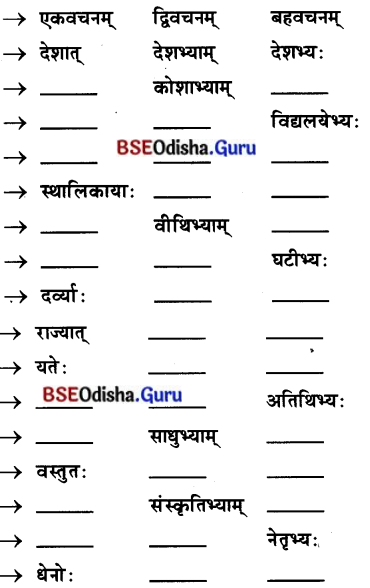

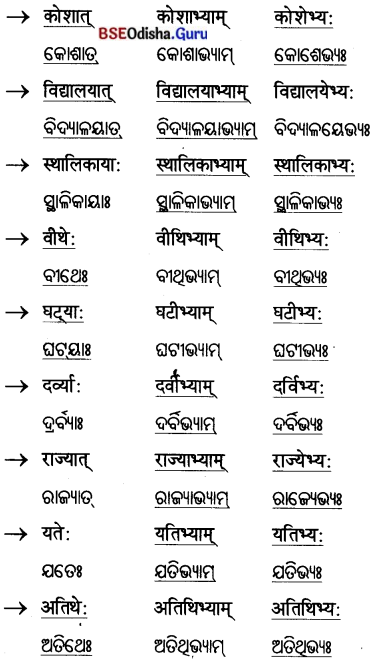
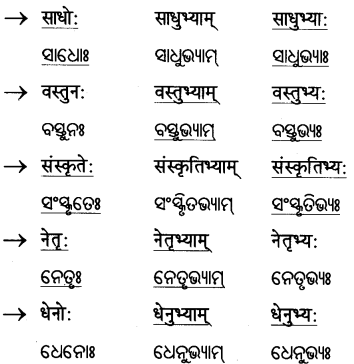
![]()
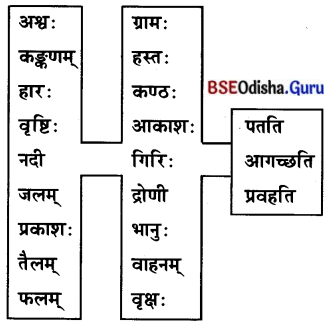
![]()
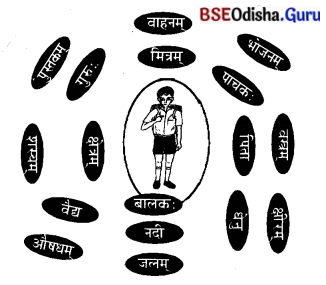
![]()
![]()
![]()
![]()
![]()
![]()
![]()
![]()
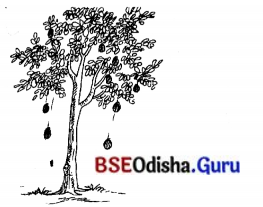
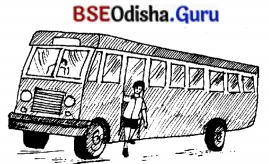
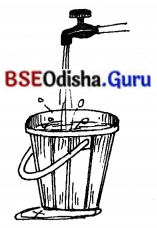
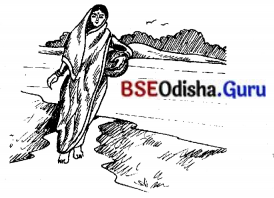
![]()
